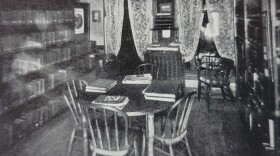It wasn’t all that long ago, just a couple generations back, that seeing a bear in Northern Wisconsin wasn’t just a wilderness encounter. It was a roadside attraction.
From the 1940s through the 1970s, tourists traveling the twisted highways of the Northwoods could spot black bears in the most unusual places: behind taverns, beside gas stations, even next to grocery stores. These weren’t taxidermy mounts or murals, but real, live bears, often kept in cages and fed treats by passersby. And what did many of them love best? Soda pop.
In McNaughton, between Minocqua and Rhinelander on Highway 47, folks fondly recall a bar known as the McNaughton Tap, sometimes called the Tamarack Bar, where a caged bear was the main draw. Visitors would stop, grab a 10-cent bottle of grape or cherry soda from the outdoor vending machine, and offer it through the bars.
It wasn’t just McNaughton. Over in Eagle River, the Honey Bear Lodge kept a bear in a cage right out front. Same story there, guests fed it soda and snacks, often before heading inside for drinks and dancing.
The Aqualand wildlife park in Boulder Junction once featured bears thirsty for a cold coca cola. And in Hiles, at a little grocery store owned by Rick Munz, yet another bear served as a roadside mascot, until the DNR stepped in and told him to find it a new home.
These practices weren’t unique to Wisconsin, but our particular mix of rural tourism, tavern culture, and deep woods made for a perfect storm. Some places even kept deer in corrals you could feed for a nickel. By modern standards, it feels strange, maybe even sad, but at the time, these bears were part of the up-north experience.
And then there were the dump bears.
Throughout the Northwoods, town dumps became nightly theaters for bear watching. Lake Tomahawk ‘s dump was famous, drawing crowds of 200 or more who’d line up in their cars like it was a drive-in movie. When the sun dipped, the bears came out, mothers, cubs, the big lumbering black bears rummaging through garbage as spectators flicked on headlights like stage lights. The performance could last 15 to 20 minutes. Locals even called it “the bear show.”
But as charming as these memories might sound, the story has a darker edge. Conservation officers began to raise the alarm. Bears that were too used to people, and their soda, started losing their natural fear. Reports rolled in of bears breaking into cabins or chasing people who teased them. One newspaper warned: “Don’t Feed or Tease Bruin, He’s Dangerous.” Humane societies found caged bears starving in off-season neglect. And slowly, public opinion shifted.
By the late 1970s and into the ’80s, most of these bear attractions faded away. New regulations, new ethics, and better understanding of wildlife management took hold. Today, a black bear sighting is once again what it always was meant to be: a rare and humbling glimpse of the wild.
And yet, bears remain an attraction, just not in cages.
These days, they surprise tourists in the most natural of ways: ambling across forest roads, poking through someone’s bird feeder at dawn, or swimming across a glass-still lake in the middle of summer. For many visitors to the Northwoods and locals alike, a bear sighting, brief and unscripted, is still one of the most thrilling moments of being in Northern Wisconsin. It’s a reminder that even in our modern world, the wild still weaves through the pines, just out of sight… until it isn’t.
Sources: Rhinelander Daily News Articles from 1940s-1970s, first hand accounts collected over the years.









